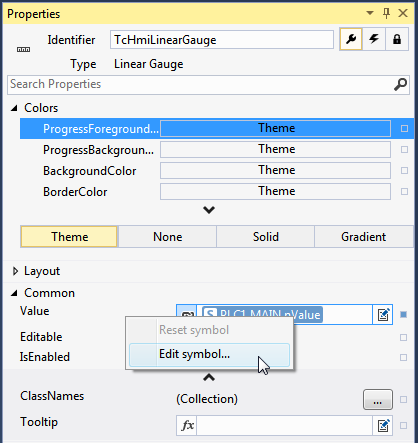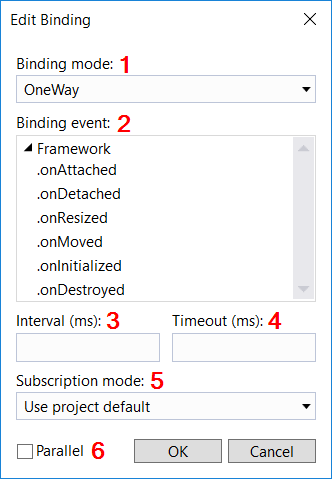Configure binding
A binding created for a property of a control can be configured via the Edit Binding dialog. The dialog can be opened by right-clicking or double-clicking on the bound symbol.

The Edit Binding dialog offers various configuration options, depending on the symbol type:

1 Binding mode: Binding mode determines whether the binding acts in one direction or in both directions.
- One-way binding (read-only): The value of the symbol is read.
- Two-way binding (read and write access): The value of the symbol is read and the symbol is written when a specific event is triggered.
2 Binding event: The binding event can only be optionally configured for TwoWay bindings. It determines at which event the symbol is written to (e.g. onValueChanged for a linear gauge). If no event is selected for a TwoWay binding, the value is automatically written back if the value changes.
- Event: An event of the current control for which the symbol is to be written to.
3 Interval: The interval specifies the time within which the binding is to be queried or updated. The interval can only be set for server symbols.
- Time (ms): Time in milliseconds.
4 Timeout: The timeout defines the time after which a read or write access to the symbol leads to an error if no response is sent from the server. The timeout can only be set for server symbols.
- Time (ms): Time in milliseconds.
5 Subscription Mode: Update mode between server and client.
- Use project default: The global setting is used, which is defined in the project properties.
- Change: The client is only informed of changes to the symbol value.
- Poll: The client receives the symbol value cyclically, even if no value change has taken place.
6 Parallel: This property defines whether a command is to be executed by the server in parallel or in a queue. The decision whether processing is to take place in parallel or in a queue depends on the respective application. By default, all commands are executed in a queue. This property can only be set for server symbols.
- Parallel (disabled): All commands to the server are queued and processed one after the other. Execution may take a little longer if there are several commands in the queue.
- Parallel (enabled): The commands are sent directly to the server without being queued. The commands are executed directly. With this option, it can happen that the execution order of commands sent in short succession is switched.
 | Available from version 1.10. |